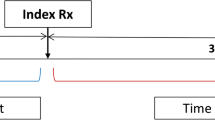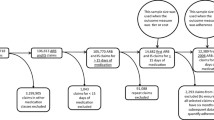ABSTRACT
BACKGROUND
Non-adherence to essential medications represents an important public health problem. Little is known about the frequency with which patients fail to fill prescriptions when new medications are started (“primary non-adherence”) or predictors of failure to fill.
OBJECTIVE
Evaluate primary non-adherence in community-based practices and identify predictors of non-adherence.
PARTICIPANTS
75,589 patients treated by 1,217 prescribers in the first year of a community-based e-prescribing initiative.
DESIGN
We compiled all e-prescriptions written over a 12-month period and used filled claims to identify filled prescriptions. We calculated primary adherence and non-adherence rates for all e-prescriptions and for new medication starts and compared the rates across patient and medication characteristics. Using multivariable regressions analyses, we examined which characteristics were associated with non-adherence.
MAIN MEASURES
Primary medication non-adherence.
KEY RESULTS
Of 195,930 e-prescriptions, 151,837 (78%) were filled. Of 82,245 e-prescriptions for new medications, 58,984 (72%) were filled. Primary adherence rates were higher for prescriptions written by primary care specialists, especially pediatricians (84%). Patients aged 18 and younger filled prescriptions at the highest rate (87%). In multivariate analyses, medication class was the strongest predictor of adherence, and non-adherence was common for newly prescribed medications treating chronic conditions such as hypertension (28.4%), hyperlipidemia (28.2%), and diabetes (31.4%).
CONCLUSIONS
Many e-prescriptions were not filled. Previous studies of medication non-adherence failed to capture these prescriptions. Efforts to increase primary adherence could dramatically improve the effectiveness of medication therapy. Interventions that target specific medication classes may be most effective.

Similar content being viewed by others
References
Burwen DR, Galusha DH, Lewis JM, et al. National and state trends in quality of care for acute myocardial infarction between 1994-1995 and 1998-1999: the medicare health care quality improvement program. Arch Intern Med. 2003;163:1430–9.
Ganz DA, Glynn RJ, Mogun H, et al. Adherence to guidelines for oral anticoagulation after venous thrombosis and pulmonary embolism. J Gen Intern Med. 2000;15:776–81.
Higashi T, Shekelle PG, Solomon DH, et al. The quality of pharmacologic care for vulnerable older patients. Ann Intern Med. 2004;140:714–20.
Jencks SF, Huff ED, Cuerdon T. Change in the quality of care delivered to Medicare beneficiaries, 1998-1999 to 2000-2001. JAMA. 2003;289:305–12.
McGlynn EA, Asch SM, Adams J, et al. The quality of health care delivered to adults in the United States. N Engl J Med. 2003;348:2635–45.
Shrank WH, Asch SM, Adams J, et al. The quality of pharmacologic care for adults in the United States. Med Care. 2006;44:936–45.
Benner J, Glynn R, Mogun H, Neumann P, Weinstein M, Avorn J. Long-term persistence in use of statin therapy in elderly patients. JAMA. 2002;288:455–61.
Matsui D, Joubert G, Dykxhoorn S, Rieder M. Compliance with prescription filling in the pediatric emergency department. Arch Pediatr Adolesc Med. 2000;154(2):195–8.
O’Connor PJ. Improving medication adherence: challenges for physicians, payers, and policy makers. Arch Int Med. 2006;166:1802–4.
Osterberg L, Blaschke T. Drug therapy-adherence to medication. N Engl J Med. 2005;353(5):487–97.
Partridge A, Wang P, Winer E, Avorn J. Non-adherence to adjuvant tamoxifen therapy in women with primary breast cancer. J Clin Oncol. 2003;21:602–6.
Partridge AH, Avorn J, Wang PS, Winer EP. Adherence to therapy with oral antineoplastic agents. J Natl Cancer Inst. 2002;94:652–61.
Siegel D, Lopez J, Meier J. Antihypertensive medication adherence in the department of veterans affairs. Am J Med. 2007;120:26–32.
Ho PM, Rumsfeld JS, Masoudi FA, et al. Effect of medication nonadherence on hospitalization and mortality among patients with diabetes mellitus. Arch Intern Med. 2006;166:1836–41.
Ho PM, Spertus JA, Masoudi FA, et al. Impact of medication therapy discontinuation on mortality after myocardial infarction. Arch Intern Med. 2006;166:1842–7.
Sokol MC, McGuigan KA, Verbrugge RR, Epstein RS. Impact of medication adherence on hospitalization risk and healthcare cost. Med Care. 2005;43:521–30.
Caro JJ, Salas M, Speckman JL, Raggio G, Jackson JD. Persistence with treatment for hypertension in actual practice. CMAJ. 1999;160(1):31–7.
Enhancing Prescription Medicine Adherence: A National Action Plan. 2007. (Accessed January 5, 2010, at http://www.talkaboutrx.org/documents/enhancing_prescription_medicine_adherence.pdf. .)
World Health Organization. Adherence to long-term therapies: evidence for action. Geneva: WHO; 2003.
Andrade SE, Kahler KH, Frech F, Chan KA. Methods for evaluation of medication adherence and persistence using automated databases. Pharmacoepidemiol Drug Saf. 2006;15:565–74.
Beardon PHG, McGilchrist MM, McKendrick AD, McDevitt DG, MacDonald TM. Primary non-compliance with prescribed medication in primary care. Br Med J. 1993;307(6908):846–8.
Ekedahl A, Mansson N. Unclaimed prescriptions after automated prescription transmittals to pharmacies. Pharm World Sci. 2004;26:26–31.
Wamala S, Merlo J, Bostrom G, Hogstedt C, Agren G. Socioeconomic disadvantage and primary non-adherence with medication in Sweden. Int J Qual Health Care. 2007;19:134–40.
Wroth TH, Pathman DE. Primary medication adherence in a rural population: the role of the patient-physician relationship and satisfaction with care. J Am Board Fam Med. 2006;19:478–86.
Bell DS, Marken RS, Meili RC, et al. Recommendations for comparing electronic prescribing systems: results of an expert consensus process. Health Affairs 2004;Jan-Jun;Suppl Web Exclusives:W4-305-17.
Shah NR, Hirsch AG, Zacker C, Taylor S, Wood GC, Stewart W. Factors associated with first-fill adherence rates for diabetic medications: a cohort study. J Gen Intern Med. 2008;24:233–7.
Shah NR, Hirsch AG, Zacker C, et al. Predictors of first-fill adherence for patients with hypertension. Am J Hypertens. 2009;22:392–6.
Lapane KL, Dubé C, Schneider KL, Quilliam BJ. Patient perceptions regarding electronic prescriptions: is the geriatric patient ready? J Am Geriatr Soc. 2007;55:1254–9.
Fischer MA, Stedman MR, Vogeli C, Ferris TG, Weissman JS. Uptake of electronic prescribing in community-based practices. J Gen Intern Med. 2008;23:358–63.
Total prevalence of diabetes in the United States, all ages, 2005. 2005. (Accessed January 5, 2010, at http://www.cdc.gov/diabetes/pubs/estimates05.htm#prev, at
Chobanian AV, Bakris GL, Black HR, et al. The seventh report of the joint national committee on prevention, detection, evaluation, and treatment of high blood pressure. JAMA. 2003;289(19):2560–72.
Jackevicius CA, Li P, Tu JV. Prevalence, predictors, and outcomes of primary nonadherence after acute myocardial infarction. Circulation. 2008;117(8):1028–36.
Solomon MD, Goldman DP, Joyce GF, Escarce JJ. Cost sharing and the initiation of drug therapy for the chronically Ill. Arch Intern Med. 2009;169(8):740–8.
Shrank WH, Hoang T, Ettner SL, et al. The implications of choice: prescribing generic or preferred pharmaceuticals improves medication adherence for chronic conditions. Arch Int Med. 2006;166:332–7.
Shrank WH, Fox SA, Kirk A, et al. The effect of pharmacy benefit design on patient-physician communication about costs. J Gen Intern Med. 2006;21:334–9.
Barbaro M, Abelson R. Relief for Some but Maybe Not Many in Wal-Mart Plan for $4 Generic Drugs The New York Times 2006 September 22, 2006.
Acknowledgements
We acknowledge the assistance of BCBSMA, Tufts HP, and ZixCorp in providing data. The investigators retained control over all aspects of the analyses and presentation of results.
The research was supported by AHRQ grant R01 HS15175.
Dr. Brookhart is supported by a career development grant from NIH (AG12084).
Dr. Shrank is supported by a career development grant from NIH (HL090505).
Conflict of Interest
None disclosed.
Author information
Authors and Affiliations
Corresponding author
Electronic supplementary materials
Below is the link to the electronic supplementary material.
ESM 1
(DOC 43 kb)
Rights and permissions
About this article
Cite this article
Fischer, M.A., Stedman, M.R., Lii, J. et al. Primary Medication Non-Adherence: Analysis of 195,930 Electronic Prescriptions. J GEN INTERN MED 25, 284–290 (2010). https://doi.org/10.1007/s11606-010-1253-9
Received:
Revised:
Accepted:
Published:
Issue Date:
DOI: https://doi.org/10.1007/s11606-010-1253-9




